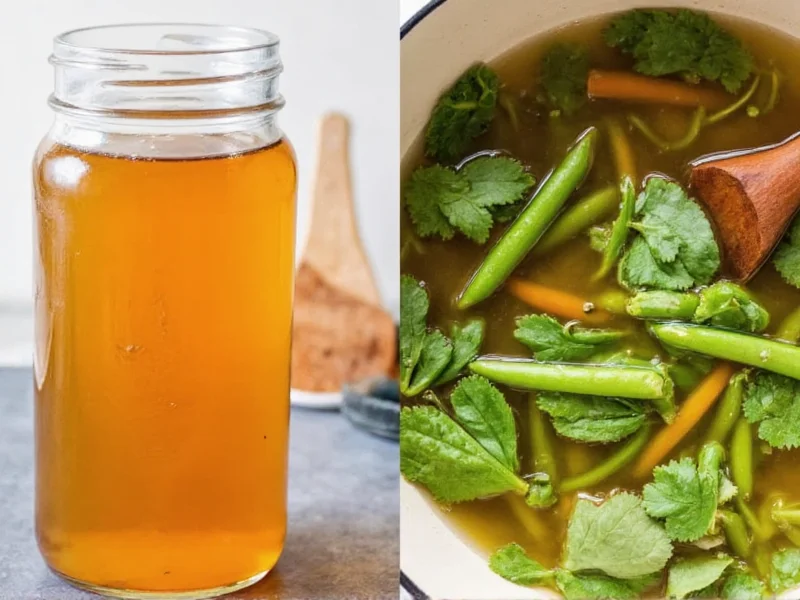Understanding the distinction between vegetable stock and vegetable broth is essential for home cooks and professional chefs alike. While these terms are often used interchangeably in grocery stores, they serve different purposes in the kitchen and yield varying results in your recipes.
Defining Vegetable Stock
Vegetable stock serves as a foundational cooking liquid in culinary applications. Chefs prepare it by simmering vegetables—typically onions, carrots, celery, and herbs—for an extended period, usually 45-90 minutes. The goal is extraction: drawing out natural flavors, colors, and textures from the vegetables without adding significant seasoning.
Unlike meat-based stocks that rely on bones for collagen and body, vegetable stock depends entirely on the vegetable matter for its structure. Properly made vegetable stock has a relatively neutral flavor profile, allowing it to blend seamlessly into sauces, soups, and braises without overpowering other ingredients.
Understanding Vegetable Broth
Vegetable broth enters the picture as a more finished product. Manufacturers or home cooks prepare it with added salt, herbs, and seasonings, creating a flavorful liquid that's enjoyable to drink straight from the container. The simmering time might be similar to stock, but the inclusion of seasoning transforms its culinary role.
Commercial vegetable broth almost always contains salt—typically 500-800mg per serving—which makes it convenient for quick soups or as a drinking broth. This added seasoning also means you'll need to adjust salt levels when using broth in recipes that call for stock.
Key Differences at a Glance
| Characteristic | Vegetable Stock | Vegetable Broth |
|---|---|---|
| Primary Purpose | Cooking foundation | Ready-to-consume liquid |
| Seasoning | Minimal or none | Significant salt and herbs |
| Flavor Profile | Neutral, subtle | Bold, seasoned |
| Simmering Time | 45-90 minutes | 30-60 minutes |
| Sodium Content | Low (5-50mg per cup) | High (500-800mg per cup) |
| Best Culinary Use | Sauces, risotto, braises | Quick soups, sipping broth |
When to Use Each in Your Cooking
Choosing between vegetable stock and broth significantly impacts your final dish. For applications where you're building complex flavors—like a rich tomato sauce or creamy risotto—vegetable stock provides the ideal neutral base that won't compete with your other ingredients.
Chefs often reach for vegetable broth when creating quick weeknight soups or when reviving leftovers. The added seasoning means less adjustment at the end of cooking. However, this convenience comes with a trade-off: you lose control over sodium levels and flavor balance.
Consider this practical scenario: when making a delicate vegetable consommé, starting with stock allows you to precisely season the final product. Using broth instead might result in an oversalted soup that lacks refinement.
Navigating Store-Bought Options
Supermarket labeling creates significant confusion in the vegetable stock versus broth debate. Many manufacturers use the terms interchangeably, with the primary difference being sodium content rather than preparation method.
When selecting commercial products, always check the nutrition label. Products labeled "stock" with high sodium content are essentially broths by another name. Look for "low-sodium" or "no-salt-added" varieties if you want true stock functionality.
For serious home cooking, consider making your own vegetable stock in large batches. Freeze it in ice cube trays for portioned use in recipes—this gives you complete control over flavor and sodium content while reducing packaging waste.
Common Misconceptions Clarified
One persistent myth suggests vegetable stock contains bones like meat stocks. This confusion stems from the meat-based stock tradition, but authentic vegetable stock contains only plant matter. The term "stock" refers to its function as a flavor foundation, not its ingredients.
Another misconception involves gelatin content. Meat stocks gel when cooled due to collagen from bones, but vegetable stock lacks this property. Don't mistake a non-gelling vegetable stock as "weak"—this is completely normal and expected.
Practical Substitution Guidance
When recipes call for vegetable stock but you only have broth (or vice versa), smart substitutions prevent culinary disasters. To convert broth to stock-like functionality, dilute it with water (typically 25-50%) and reduce added salt elsewhere in your recipe.
Conversely, if substituting stock for broth in a sipping application, enhance it with additional salt, herbs, and perhaps a splash of acid like lemon juice to create a more complete flavor profile. Remember that homemade versions offer the most flexibility for these adjustments.
Making Superior Vegetable Stock at Home
Creating professional-quality vegetable stock requires attention to detail. Start with fresh, aromatic vegetables—avoid strong-flavored items like broccoli or Brussels sprouts that can dominate the flavor profile. Roasting vegetables before simmering develops deeper flavors through the Maillard reaction.
Simmer gently rather than boiling vigorously, which can make the stock bitter. Strain thoroughly through cheesecloth for crystal-clear results. For maximum versatility, prepare your stock without salt so you can control seasoning in every application.











 浙公网安备
33010002000092号
浙公网安备
33010002000092号 浙B2-20120091-4
浙B2-20120091-4